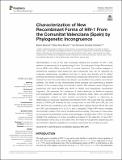Por favor, use este identificador para citar o enlazar a este item:
http://hdl.handle.net/10261/220654COMPARTIR / EXPORTAR:
 SHARE SHARE
 CORE
BASE CORE
BASE
|
|
| Visualizar otros formatos: MARC | Dublin Core | RDF | ORE | MODS | METS | DIDL | DATACITE | |

| Título: | Characterization of new recombinant forms of HIV-1 from the Comunitat Valenciana (Spain) by phylogenetic incongruence |
Autor: | Beamud, Beatriz CSIC ORCID; Bracho, María Alma; González-Candelas, Fernando CSIC ORCID | Fecha de publicación: | 2019 | Editor: | Frontiers Media | Citación: | Frontiers in Microbiology 10: 1006 (2019) | Resumen: | Recombination is one of the main processes shaping the evolution of HIV-1, with relevant consequences for its epidemiology. In fact, Circulating and Unique Recombinant Forms (CRFs and URFs) cause 23% of current infections. The routine analyses of antiretroviral resistance yield partial pol gene sequences that can be exploited for molecular epidemiology surveillance but also to study viral diversity and to detect potential recombinant samples. Among the pol sequences derived from a large sample dataset from the Comunitat Valenciana (Spain), we identified nine putative recombinant samples. We aimed at fully characterizing these samples and performing a detailed analysis of the corresponding recombination events. We obtained nearly full-genome sequences and used jpHMM and RDP4 to detect and characterize recombinant fragments. We assessed the confidence of these inferences by likelihood mapping and phylogenetic placement with topology congruence tests. Next, we performed a phylogenetic analysis of each putative recombinant fragment to determine its relationships to previously described recombinant forms. We found that two samples related to CRF44_BF whereas the rest corresponded to new URFs (two URF_AD, one URF_BG that can constitute a new CRF resulting from subtype B and CRF24_BG, and two URF_cpx composed of A, G, K, H, and J subtypes). These URFs have a complex recombination pattern that cannot be determined accurately. They seem to have arisen by successive recombination events among lineages, including other CRFs. Our results highlight the usefulness of routine surveillance analysis for the detection of new HIV-1 recombination forms and, at the same time, the need for full-genome sequencing and recombination detection guidelines to properly characterize this complex process. | Versión del editor: | https://doi.org/10.3389/fmicb.2019.01006 | URI: | http://hdl.handle.net/10261/220654 | DOI: | 10.3389/fmicb.2019.01006 | E-ISSN: | 1664-302X |
| Aparece en las colecciones: | (I2SysBio) Artículos |
Ficheros en este ítem:
| Fichero | Descripción | Tamaño | Formato | |
|---|---|---|---|---|
| characincongru.pdf | 1,85 MB | Adobe PDF |  Visualizar/Abrir |
CORE Recommender
PubMed Central
Citations
5
checked on 17-abr-2024
SCOPUSTM
Citations
7
checked on 11-abr-2024
WEB OF SCIENCETM
Citations
7
checked on 26-feb-2024
Page view(s)
114
checked on 18-abr-2024
Download(s)
175
checked on 18-abr-2024

